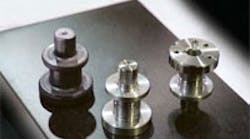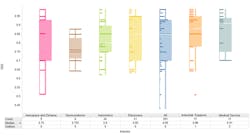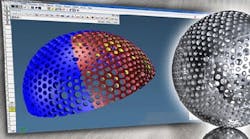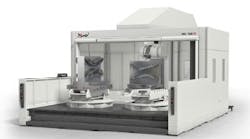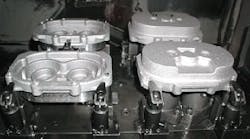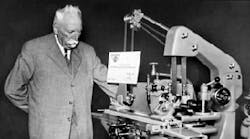When MKM is approached to take on a new job, those at the shop who are involved in the project first consider the best way to manufacture the parts and the equipment that is needed to do so. They don’t just try to adapt the job to the shop’s existing equipment.
If the “ideal” equipment is in-house, great, but if not, MKM (www.mkmmachine.com) is willing to invest in new technology.
That is what happened when the shop won a job to produce automotive camshaft nosepieces.
It decided the best equipment for the job would be 13-axis multispindle machines, and it went out and purchased three of them from Index Corp. (www.index-usa.com). One of the machines came equipped with a built-in robot that allows it to run bar-fed work or blanks as a chuckertype machine, and that option usually is not possible with such machines.
“Most shops are unwilling to take the leap into investing in new equipment. But we can honestly say that the Index machines gave us an advantage in winning the nose piece job,” MKM’s Dan Peterworth, president, said.
The auto suppliers that awarded MKM the job were familiar with Index machines, and the fact that the shop had such machines gave the new customers confidence that the work would get done right. The machines also have won other new projects for MKM.
“For the nose piece job, the Index machines were the best machines available. They hold the tolerances and concentricity we need, their tooling abilities are endless and, since they are single machines, we only have to deal with one work setup and one set of tooling for each machine,” Peterworth said.
The three Index machines are 6-spindle MS52 CNC Bar/ Chucker models with 2-in. bar capacities and 4-in. chuck capacities. The first machine is configured as a chucker with rear linear automation designed and integrated by AuE-US Inc. from Ann Arbor, Mich. The second Index machine also is configured as a chucker machine, but includes the built-in robot, which was supplied by Staubli. The third machine operates as a bar-fed machine.
MKM opted for the built-in robot/chucker option mainly because of metal-removal issues.
For one type of camshaft nose piece design, the shop would have had to machine the part from large-diameter barstock. That would have wasted as much as 700,000 pounds worth of material per year, Steve Prentice, engineering sales manager for the shop, said.
Having the robot allows the shop to use cold-forged part blanks made of 4130 steel. These near-net-shape blanks require less machining and save about 50 cents per part in material. That leads to a significant savings considering that the three Index machines eventually will process about 1.2 million pieces a year for the next three or four years.
The robot also lets MKM run part blanks that are bigger than the machine’s through-spindle size. It is not limited by the machine’s maximum barstock diameter capacity as it would be if the machine were bar-fed. That is a noteworthy advantage because if MKM ran the nosepieces from barstock instead of cold forgings, the raw barstock would have to be larger in diameter than the machine’s throughspindle diameter.
The Index machines were the first CNC multispindle chucking machines to offer an open front work area that permits robot loading of forgings, castings or extrusions up to approximately 4 in. in diameter. Typically, shops use a simple shuttle system, a standard pallet or a belt-type conveyor system to deliver parts to the robot loader.
In addition, the open-front design provides exceptional ease of operation and ergonomic convenience that results in significant time savings for set up, changeovers and toolchanges. In addition, the design provides unrestricted chip flow.
To develop the open front, Index eliminated the machine’s end slide tool carrier and its opposed headstock and put the machine’s electrical system at the top of the machine.
A spindle drum is at the heart of the Index machines, and it has a special, three-ring face tooth coupling mechanism to ensure high precision indexing of the spindle drum. Six independent spindle motors allow optimum cutting speeds for each tool and provide a dramatic increase in productivity.
The optimum cutting speeds combine with 2-axis contouring and programmable feedrates to allow the machine to control part quality and chip flow. Those are essential capabilities for machining tough alloy and stainless steel materials.
The concept for the machine’s CNC tool carriers is a spacesaving vertical design that accepts quick-change pre-settable tooling. The machines can be equipped with as many as 12 tool carriers, and O.D., I.D. or live tools can be used in any slide position. As many as three I.D. tools can be mounted in a gangstyle arrangement on any one of the two-axis slides to extend the machine tool’s capacity.
Most spindle positions offer twoaxis or four-axis machining, and because most slides are capable of CNC contouring, they eliminate the need for form tools while allowing the use of standard insert tools in nearly all positions. Index said such single-point insert tooling optimizes part surface finishes and chip flow.
Shops can mount a wide variety of live tool attachments in any spindle position on the machines. Live tools can be used for drill/mill operations, to generate polygon shapes even in materials such as stainless steel, and for gear hobbing. Optional Y axes on the slides and C axes on the main spindles extend machine application ranges to complete parts in single setups and eliminate secondary operations.
